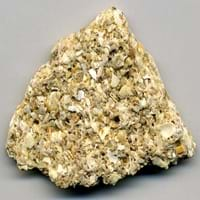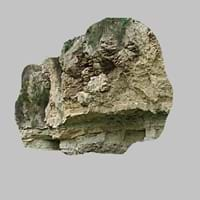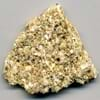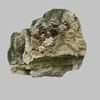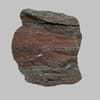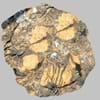Definition
Coquina is a sedimentary rock that is composed either wholly or almost entirely of the transported, abraded, and mechanically-sorted fragments of the shells of molluscs, trilobites, brachiopods, or other invertebrates
A water-soluble mineral sediment resulting from concentration and crystallization by evaporation from an aqueous solution
Origin
European Foreland Basins
USA
Discoverer
Unknown
Usiglio
Etymology
From Concha (Latin)+ Coquina(Spanish) +conch(English)= Couquina (mid 19th century)
From a sediment left after the evaporation
Class
Sedimentary Rocks
Sedimentary Rocks
Sub-Class
Durable Rock, Soft Rock
Durable Rock, Soft Rock
Group
Not Applicable
Not Applicable
Other Categories
Coarse Grained Rock, Opaque Rock
Coarse Grained Rock, Fine Grained Rock, Medium Grained Rock, Opaque Rock
Color
Beige, Buff, Orange
Colourless, Green, Grey, Silver, White
Durability
Non-Durable
Durable
Appearance
Layered, Banded, Veined and Shiny
Glassy, Vesicular and Foilated
Interior Uses
Decorative Aggregates, Homes, Hotels, Interior Decoration
Decorative Aggregates, Entryways, Flooring, Homes, Interior Decoration
Exterior Uses
Garden Decoration, Office Buildings
As Building Stone, As Facing Stone, Garden Decoration, Paving Stone
Other Architectural Uses
Curbing
Curbing
Construction Industry
Building houses or walls, Construction Aggregate
As a Flux in the Production of Steel and Pig Iron, As a Sintering Agent in Steel Industry to process Iron Ore, As Dimension Stone, Cement Manufacture, for Road Aggregate, Making natural cement, Manufacture of Magnesium and Dolomite Refractories
Medical Industry
Not Yet Used
Taken as a Supplement for Calcium or Magnesium
Antiquity Uses
Artifacts, Monuments, Sculpture, Small Figurines
Artifacts
Commercial Uses
Creating Artwork
Used in the manufacture of Ceramic Powder, Used in the preparation of Sulfuric Acid and Silicon Diborite
Types
Not Available
Not Available
Features
Available in Lots of Colors and Patterns, Is one of the oldest rock
Generally rough to touch, Splintery, Veined
Archaeological Significance
Monuments
Used
Not Yet Used
Famous Monuments
Data Not Available
Not Applicable
Sculpture
Used
Not Yet Used
Famous Sculptures
Data Not Available
Not Applicable
Figurines
Used
Not Yet Used
Formation
Coquina is a sedimentary rock which is formed when billions of small clam-like seashell, called Coquina, or cockleshell are die and hence are deposited, buried and turns into a rock when pressure is applied.
Evaporite is water-soluble mineral sediment which forms from concentration and crystallization by evaporation from an aqueous solution.
Mineral Content
Apatite, Augite, Bronzite, Calcite, Chert, Chlorite, Clay Minerals, Epidote, Feldspar, Garnet, Micas, Muscovite or Illite
Calcite, Cancrinite, Gypsum, Kyanite, Magnetite
Compound Content
CaO, Carbon Dioxide, Iron(III) Oxide, MgO
CaMg(CO3)2, CaO, Calcium Sulfate, KCl, MgO, NaCl
Types of Metamorphism
Not Applicable
Burial Metamorphism, Cataclastic Metamorphism, Contact Metamorphism, Impact Metamorphism, Regional Metamorphism
Types of Weathering
Biological Weathering, Chemical Weathering, Mechanical Weathering
Not Applicable
Types of Erosion
Coastal Erosion, Sea Erosion, Water Erosion, Wind Erosion
Not Applicable
Grain Size
Coarse Grained
Medium to Fine Coarse Grained
Fracture
Irregular
Conchoidal
Porosity
Highly Porous
Less Porous
Luster
Dull to Vitreous to Submetallic
Subvitreous to Dull
Compressive Strength
Not Available
Cleavage
Not Available
Perfect
Toughness
Not Available
Not Available
Specific Gravity
1.10-2.24
2.86-2.99
Transparency
Opaque
Translucent
Density
2.8-2.9 g/cm3
2.8-2.9 g/cm3
Specific Heat Capacity
Not Available
Resistance
Heat Resistant, Impact Resistant, Pressure Resistant, Wear Resistant
Heat Resistant, Pressure Resistant
Deposits in Eastern Continents
Asia
Not Yet Found
Not Available
Africa
Not Yet Found
Not Available
Europe
United Kingdom
United Kingdom
Others
Not Yet Found
Not Yet Found
Deposits in Western Continents
South America
Not Yet Found
Colombia, Paraguay
Deposits in Oceania Continent
Australia
Not Yet Found
Central Australia, Western Australia
All about Coquina and Evaporite Properties
Know all about Coquina and Evaporite properties here. All properties of rocks are important as they define the type of rock and its application. Coquina and Evaporite belong to Sedimentary Rocks.Texture of Coquina is Clastic whereas that of Evaporite is Earthy. Coquina appears Layered, Banded, Veined and Shiny and Evaporite appears Glassy, Vesicular and Foilated. The luster of Coquina is dull to vitreous to submetallic while that of Evaporite is subvitreous to dull. Coquina is available in beige, buff, orange colors whereas Evaporite is available in colourless, green, grey, silver, white colors. The commercial uses of Coquina are creating artwork and that of Evaporite are used in the manufacture of ceramic powder, used in the preparation of sulfuric acid and silicon diborite.
